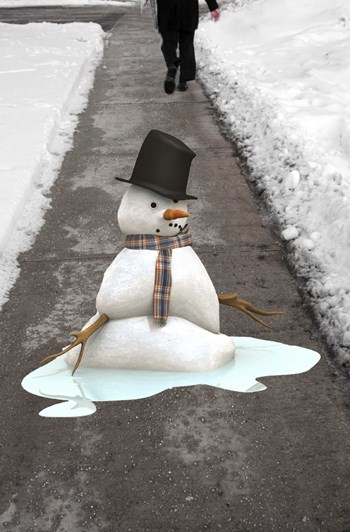
Two winters ago, the Massachusetts Supreme Judicial Court overturned 125 years of legal precedent and announced a new rule of law, making property owners legally responsible for the removal of snow and ice from their property. (Papadopoulos v. Target Corp.)
That was the straw that broke the proverbial camel’s back. Consequently, Massachusetts now has to follow the lead of other states in helping to reduce the risk of falls by removing ice and snow from each property promptly. For condo associations, that means reconsidering old ways—the rock salt that notoriously damages carpets and concrete—against newer blends of products that can be less corrosive and more environmentally-friendly, and high-tech solutions like radiated heat.
What’s a conscientious board to do? Bone up, primarily. It’s your job.
Bernie Gitlin of Risk Strategies Co. in Randolph, Massachusetts, advises clients to just get ‘er done.
“In the ‘olden days,’ in the People’s Republic of Massachusetts, if it snowed and you did not touch the snow—therefore it was considered a ‘normal’ accumulation—and somebody came in and fell on it, the landowner would not be responsible for any injury to the claimant. Meanwhile, the rest of the world treated things differently, and basically said you, as the owner, are responsible for keeping your property safe.
“That’s the case in Massachusetts now, and so therefore you, as a condo association or landlord of any type, can’t get away with this ‘natural/unnatural’ accumulation (argument).”
Failing to clean up snow or ice promptly can result in expensive lawsuits, which are popping up more frequently. And that’s a mighty incentive.
“Litigation has become far more prevalent in Massachusetts than it used be. Insurance companies do not have the same protection that they used to have (under state law),” Gitlin said.
Short and sweet, the solution is action. But choosing the cold weather weapon of choice can be complicated.
It’s the Law
Check your liability insurance, says Richard D. Vetstein of Vetstein Law Group Inc. in Massachusetts. Vetstein’s web blog, The Massachusetts Real Estate Law Blog, advises: “Whether a property owner takes reasonable steps in removing snow and ice will be determined by juries on a case-by-case basis. While this ruling is good for public safety, it has the potential to result in more slip-and-fall cases being filed, and possibly additional insurance costs.”
Increasing the amount of liability coverage may be needed as well, he says.
Others in the condominium industry recognize the wisdom of that caution.
“In this age of litigious people, slips and falls are a common occurrence—one we try to guard against,” says Michael Pasquino, senior portfolio manager with Barkan Management in Boston, a large property management firm.
“Some property managers will do snow removal themselves, depending on their staffing and budget, or the vendor contracted for the property (for plowing, as an example) will be responsible for sidewalks, driveways, and so on.”
For the most part, Pasquino says, property managers aren’t switching to high-tech solutions like electric or thermal underground heat, out of basic concern for costs. “It’s expensive to try and retrofit them with heated sidewalks.”
Instead, he says, most seek less costly solutions, mindful of the environment at the same time. “The only thing that’s a little outside regular salting is using chemicals available now that are more green; they have less of an impact on the environment, runoff and so on. The days of putting down rock salt and chemicals damaging to both sidewalks and the interior that people track in (are passing),” Pasquino says. Greener chemical treatments are more expensive, which stops some property managers, he says, but they must be considered in light of the repair costs that can be avoided. “And boards are more environmentally sensitive now.”
While most properties remain users of the various salt blends that melt ice at entrances and in lots, there are several variations now, and they are used according to climate and conditions.
According to manufacturers, not all ice melts are alike; that’s especially the case now that more than one hundred ice melt products exist. By mixing the chemical blend, makers can offer products to vary melting temperatures. Consult the manufacturers’ websites or your product dealer to learn which of them works best in your circumstances.
Claims of environmentally “green” products can be suspect, as there aren’t many trade regulations on these products, so the Federal Trade Commission has created updated Green Guides to help manufacturers and users. When purchasing, it says, look for substantiated claims, such as third-party guarantees, rather than possibly deceptive product labeling. Look for additional information at http://www.epa.gov/dfe/pubs/projects/formulat/formpart.htm#44, the EPA’s Designs for the Environment website.
Crunching the Numbers
Winter in New England is a tricky wicket, which makes budgeting tough. Cost may be a factor, but associations are wise to remember the cost of lawsuits. Paying for plowing and sidewalk treatment can drain the budget in a tough winter, but it’s not optional, so planning is vital. At many locations, the plowing contractor also serves as the company providing snow-melt service.
Some managers, says Barkan’s Pasquino, opt for protection in advance, while others take their chances. “Some associations will sign an all-inclusive agreement with a vendor,” Pasquino says. “I’ve got a number that have a contractor they like working with, and they’ll be given the option for what I call a la carte service: you pay as you go.”
In other situations, they may have taken the more risky option of paying a pre-set amount, and ice removal becomes a single-priced expenditure for the year. “A lot of property managers like doing that because it helps with budgeting,” Pasquino says. “If the annual contract is $15,000, they may pay $3,000 per month over five months—no matter whether it snows or doesn’t, that’s what you pay.”
“Last winter, we had no snow, so [the vendor’s] only function was to take the check to the bank every month and cash it,” he says. “But the year before, we had so much snow that associations would have been killed on costs (with the single-pay situation). It’s a gamble, and boards have to decide on how they want to go.”
At Barkan properties, he says, “We’ll take a 5-year average of use” in budgeting estimates.
High-Tech Alternative
Savvy managers take steps to protect surfaces against any type of damage: replaceable mats against tracked-in materials, extra sealing of floors before winter. But there is another option—one that is better accomplished during the construction phase: radiant heat. Because of its cost, this type of system may also be done when sidewalks are being replaced or otherwise changed.
Uponor is an international corporation operating radiant systems for heating and cooling in many countries, some of which have an abundance of ice and snow, like Norway, Finland and Sweden. Circulating a water or water/glycol solution through cross-linked polyethelene (PEX) tubing beneath concrete, turf, asphalt or similar surfaces, the radiant system warms ground surfaces to a temperature that will melt snow and ice on contact.
One major benefit is its usefulness on areas that are hard to plow, such as steeply graded roadways and pavers or other easy-to-damage surfaces. Equipped with sensors, the system is automated, tuned to respond to need.
“A lot of what we’ve done is on the tail end of what European technology started,” says Jeff Wiedemann, product manager, radiant controls for Uponor North America, based in Apple Valley, Minnesota, a suburb of the Twin Cities. “Radiant heating is prevalent there, specifically in Sweden, and they build for snow melting,” he says. “Their applications are quite a bit smaller, so we expanded on it and (Uponor) systems kept getting bigger. We saw the opportunity not only for space heating but for snow removal.”
Now, even some NFL fields and other sports complexes are treated by this method, he says.
Another great benefit of these systems is their rapid response in areas where handicap access, emergency traffic, and such things as helicopter landing pads are considered.
These systems, while more costly to install after a property has been completed, are becoming more of a must in luxury markets, where they can be connected to modulating-condensing (mod-con) boilers or even waste-heat sources for added efficiency. “They help lower maintenance costs, and reduce the liability associated with slippery walkways,” Wiedemann says. And those costs can be considerable. He points out the cost of a slip-and-fall lawsuit, for one thing, and for another the recent example of Long Island’s transit platforms—so corroded by chemical wear that they had to be replaced.
“Once it’s in,” Wiedemann says, “it has a long life—well over a hundred years.” He calls the sturdy tubing “polyethelene with an attitude.”
Just as solar heat is becoming a solution to electricity costs, pre-installed tubing can be married to a green hydrological system for winter ice removal. Excess heat can be used for snow removal, he says. During the summer, solar panels heat pool water; in the winter, they provide heat for a snow melt system. “In Holland, Michigan, an area of six city blocks is melted by processed water from the city’s water plant.” Ironically, the Environmental Protection Agency told the city its processed water was clean but too hot to dump. “So they ran that water through a heat exchanger to get free hot water,” he said.
Another savings is realized through the elimination of tracked-in chemicals that destroy entryways and carpeting.
As a matter of safety, removing snow and ice quickly from areas that decline toward roads with a lot of traffic is critical, Wiedemann says. “We had a car wash in St. Paul (Minnesota), where cars slid out into oncoming traffic, so we did that area.”
Most of the time, the water evaporates and what doesn’t is tracked in the way normal rain runoff is handled. Engineering has to consider that problem just as it does for rain.
These systems are also expandable or contractable to fit square footage.
Regardless of what choices managers make, they must choose to take action: “Clean off the property! There is no solution other than the proper solution,” Gitlin says. “Nowadays, there is just a bigger chance of a problem.”
Ann Connery Frantz is a freelance writer and a frequent contributor to New England Condominium.






Leave a Comment